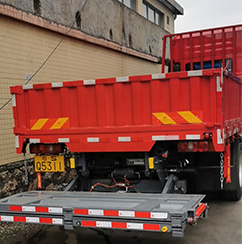In order to reduce wind resistance and energy consumption during the driving process of trucks, there are various optimization measures for the appearance design of the truck tailboard, including:
Adopting streamlined design: Traditional truck tailboards are mostly rectangular in shape, which can easily generate vortices when airflow passes through, increasing wind resistance. Designing the edge of the tailboard as a rounded streamline, such as using an arc-shaped transition, can make the airflow flow more smoothly over the surface of the tailboard, reducing airflow separation and vortex generation. Taking a certain brand of truck as an example, by changing the edge of the tailboard to an arc with a radius of 5 centimeters, wind tunnel tests have shown that the drag coefficient can be reduced by about 8%.

Design diversion structure: Installing diversion plates or grooves on the tail plate is a common optimization method. The deflector is usually installed on the top or both sides of the tailboard to guide the airflow in a specific direction and avoid turbulence. The diversion groove is a groove opened on the surface of the tail plate, which can allow the airflow to adhere to the surface of the tail plate and reduce the detachment of the airflow. Some large logistics trucks have installed 10 centimeter high deflectors on both sides of the tailboard. Actual road tests have shown that they can effectively reduce wind noise while also reducing energy consumption.
Optimizing the angle of the tailboard: The angle between the tailboard and the truck body has a significant impact on wind resistance. Generally speaking, when the tailboard forms an angle of 10 ° -15 ° with the vehicle body, the airflow passes more smoothly. When the tailboard is perpendicular to the vehicle body, the airflow will create a significant pressure difference at the tailboard, increasing wind resistance. By conducting wind tunnel experiments and actual road tests to adjust the angle of the tailboard, the wind resistance of the truck can be reduced during driving, achieving energy-saving effects.
Adopting lightweight and low wind resistance materials: using materials with low density, high strength, and smooth surface to make the tailboard can not only reduce the overall weight of the truck, but also reduce wind resistance. If carbon fiber composite materials are used instead of traditional steel, the weight of the tailboard can be reduced by 30% -50%, and its smooth surface can reduce the frictional resistance of the airflow.
Integrated design: Integrate the tailboard with the truck body to make it a part of the overall appearance of the truck, reducing the interference of airflow between the two. For example, by integrating the tailboard with the rear bumper, side panels, and other components of a truck, a continuous surface can be formed, allowing airflow to pass smoothly and effectively reducing wind resistance and energy consumption.

Professional to provide security
for modern logistics
A new company that efficiently handles
and unloads equipment
Please do not hesitate to contact us
0769-81251088

Add friend consultation